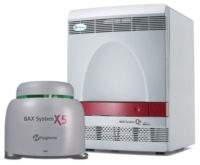Are PCR-based methods appropriate for the detection of Listeria spp. in environmental surface samples?
It is standard practice within the industry for food processors to evaluate efforts to control and eliminate Listeria monocytogenes from finished product by monitoring the presence of the genus Listeria within the processing facility. The recurring presence of any Listeria spp. may indicate ineffective sanitation practices that can lead to the niche growth and establishment of L. monocytogenes. If established, there is a high risk that product contamination may occur. The strategy of environmental monitoring in conjunction with quick and aggressive response to positive test results allows processors to continually improve their operations and minimize any risk to finished product. However, the success of these efforts rests heavily on the performance of the chosen detection method.
The most common Listeria detection methods include agar or film plating methods, antibody-based lateral flow or enzyme immunoassays (EIA) and polymerase chain reaction (PCR) methods. Of these different technologies, PCR typically offers the highest degree of sensitivity and specificity. However, not all PCR systems are capable of dealing with the complexities of detecting Listeria from environmental samples. While generally better at preventing false positives from cross-reacting organisms, the DNA sequences targeted by some PCR systems actually prevent them from detecting all Listeria spp. To serve as a truly effective food safety diagnostic tool, a Listeria detection method should be able to reliably detect all members of the Listeria genus. Once identified, the necessary corrective actions can be initiated to address these specific potential problem areas through focused cleaning, sanitation, and follow up monitoring efforts. As such, methods that fail to detect one or more Listeria species are ultimately less effective at controlling Listeria than those capable of detecting all species and may actually undermine the organization’s efforts to reduce the risk of product contamination.
PCR Pitfalls
One of the often sited difficulties associated with the use of PCR for detection of foodborne pathogens is its susceptibility to inhibition. PCR can be inhibited by ionic detergents, high concentrations of salt, complex polysaccharides, proteinases, etc. These inhibitors generally exert their effects through direct interaction with the DNA itself or interference with the polymerase enzymes responsible for producing the DNA copies. Environmental surface samples from processing facilities are likely to contain one or more PCR inhibitors that originate from cleaning and sanitizing agents, food product residues and even the buffers or media found in the sample collection device. As such, any PCR method must have a suitable mechanism for counteracting these inhibitory compounds that can otherwise lead to indeterminate or false negative results. The standard approach is to dilute the sample through a multi-step enrichment protocol and a sample preparation process. While typically successful at preventing inhibition, this type of dilution protocol can also reduce the method’s sensitivity by providing as little as 1.25 µL of the enrichment for PCR analysis. This may compromise its ability to function as an effective food safety diagnostic tool.
Avoiding Those Pitfalls
BioControl Systems’ Assurance GDS™ for Listeria spp. applies microbiology and genetic detection technologies that enable the system to overcome many of the pitfalls commonly associated with using PCR The method includes an immunomagnetic separation (IMS) sample preparation procedure that addresses the problems associated with PCR inhibition without compromising sensitivity. The procedure utilizes IMS technology to capture the Listeria present in the sample enrichment, concentrate them onto antibody-coated magnetic particles and physically separate the Listeria from any potential inhibitory compounds. Additionally, it provides the added benefit of reducing the level of Listeria required at the conclusion of the enrichment process. As such, the total enrichment time can be reduced to just 22 hours.
Beyond IMS, the system contains two additional levels of specificity in the form of DNA primers and probes. Because both are comprised of highly specific single strand DNA sequences complimentary to the target DNA, their combined presence ensures that only the target DNA sequences are amplified and detected. Because the sequences contained in the primers and probes target highly conserved DNA sequences from specific genes common to the entire Listeria genus, all members of the genus can be detected.
Historically, the pitfalls associated with PCR may have outweighed its potential benefits as a tool for environmental monitoring. However, recent advancements in technology have enabled processors to accurately and reliably detect the presence of Listeria spp. from environmental surface samples. The ability to provide definitive positive and negative results for all Listeria spp. in just 24 hours has made PCR a truly practical and valuable component of any food safety program.
www.biocontrolsys.com
Pitfalls of Environmental Testing for Listeria with PCR



